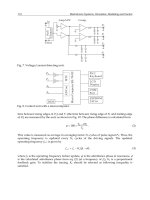Mechatronic Systems, Simulation, Modeling and Control 2012 Part 12 potx
Bạn đang xem bản rút gọn của tài liệu. Xem và tải ngay bản đầy đủ của tài liệu tại đây (254.62 KB, 5 trang )
MechatronicSystems,Simulation,ModellingandControl294
3.6 Example of an optimal synthesis of an integrated flexible piezoelectric actuator
The concepts presented previously have been applied to the design of a microgripper
actuator, considering a multi-criteria optimization problem, with both static mechanical
(free stroke and blocking force at the output node of the structure) and control-oriented J
1
and J
2
fitnesses.
The synthesis of a symmetric monolithic microactuation mechanism, made of a single
piezoelectric material (PIC151 from PI Piezo Ceramic Technology) has been made using our
method. From the set of structures results, one pseudo-optimal solution, whose topology is
presented on Fig. 7, is chosen to illustrate performances.
Fig. 7. On the left, model of the piezoeletric device with top face electrode patterns - V
left
(resp. V
right
) is the controlled input for actuating the left (resp. right) arm. On the right,
photo of the prototyped piezoelectric device, obtained by laser cutting.
Fig. 8. Bode amplitude diagram of the chosen solution between input (voltage u, in V) and
arm output (deflection in μm) simulated by our method.
Each arm of such a microgripper is able to produce ±10.69μm movement range when ±100V
is applied on the actuation electrodes. A blocking force of about 840mN is also produced.
Moreover, this solution is an example of structure with interesting control-oriented criteria
(Fig. 8): the authority control on the two first resonant modes is well optimized, resulting in
an important roll-off after the second resonance. As expected, this structure exhibits an
alternating pole/zero pattern in the spectrum of interest.
4. Conclusion
A brief overview of design specificities and strategies including mechanical and control
considerations for micromechatronic structures has been presented. Designing, modelling
and controlling flexible microscale structures actuated by active materials are a quite
complex task, partly because the designer has to deal with several problems. Amongst them,
specific mechanical performances, spillover treatment, model reduction techniques and
robust control have been highlighted in this chapter.
To help the design of such systems, an example of a systematic optimal design method for
smart compliant mechanisms has been particularly presented here. This method can
consider a smart compliant mechanism as an assembly of passive and active compliant
building blocks made of PZT, so that actuators are really integrated in the structure.
Complex multi-objective design problems can be solved, taking advantage of versatile
criteria to synthesize high performance microrobotic flexible mechanisms designs. In
addition to classical mechanical criteria, currently encountered in topology optimization (i.e.
force and displacement maximization), our method considers now simultaneously efficient
control-based criteria.
Open-loop transfer considerations lead to two new efficient numerical criteria. A first
criterion can modulate resonances amplitudes of its frequency response function in a
spectrum of interest. A second criterion can force minimum-phase system property. These
two criteria, coupled with mechanical ones, help designing non-intuitive compliant
mechanisms. This optimization strategy was tested for the optimal design of a microgripper
actuator. The results obtained have proved that the method can furnish innovative and
efficient solutions.
5. References
Abdalla M., and al. (2005), Design of a piezoelectric actuator and compliant mechanism
combination for maximum energy efficiency, Smart Material and Structures, vol. 14,
pp. 1421-1430, 2005
Abreu G. L. C., Ribeiro M., Steffen J. F. (2003), Experiments on optimal vibration control of a
flexible beam containing piezoelectric sensors and actuators, Journal of Shock and
Vibration, vol. 10, pp. 283-300, 2003
Agnus J., Nectoux P. , Chaillet N. (2005), Overview of microgrippers and micromanipulation
station based on a MMOC microgripper, Proc. of the IEEE International Symposium on
Computational Intelligence in Robotics and Automation, pp. 117-123, 2005
Aphale S. S., Fleming A.J., Moheimani S. O. R. (2007), Integral resonant control of collocated
smart structures, Smart Materials and Structures, vol.16, pp. 439-446, 2007
Barboni R., and al. (2000), Optimal placement of PZT actuators for the control of beam
dynamics, Smart Material and Structures, pp. 110-120, 2000
Bernardoni P., and al. (2004a), A new compliant mechanism design methodology based on
flexible building blocks, Smart Material and Structures, vol. 5383, pp. 244-254, USA,
2004
Bernardoni P. (2004b), Outils et méthodes de conception de structures mécaniques à
déformations réparties et actionnement discret – applications en microrobotique,
PhD Thesis realized at the CEA, University Paris 6, France, 2004
Breguet J.M. (1997), and al., Monolithic piezoceramic flexible structure for
micromanipulation, 9th International Precision Engineering Seminar and 4th
International Conference on Ultraprecision in Manufacturing Engineering, pp. 397-400,
Braunschweig Germany, 1997
ContributionstotheMultifunctionalIntegrationforMicromechatronicSystems 295
3.6 Example of an optimal synthesis of an integrated flexible piezoelectric actuator
The concepts presented previously have been applied to the design of a microgripper
actuator, considering a multi-criteria optimization problem, with both static mechanical
(free stroke and blocking force at the output node of the structure) and control-oriented J
1
and J
2
fitnesses.
The synthesis of a symmetric monolithic microactuation mechanism, made of a single
piezoelectric material (PIC151 from PI Piezo Ceramic Technology) has been made using our
method. From the set of structures results, one pseudo-optimal solution, whose topology is
presented on Fig. 7, is chosen to illustrate performances.
Fig. 7. On the left, model of the piezoeletric device with top face electrode patterns - V
left
(resp. V
right
) is the controlled input for actuating the left (resp. right) arm. On the right,
photo of the prototyped piezoelectric device, obtained by laser cutting.
Fig. 8. Bode amplitude diagram of the chosen solution between input (voltage u, in V) and
arm output (deflection in μm) simulated by our method.
Each arm of such a microgripper is able to produce ±10.69μm movement range when ±100V
is applied on the actuation electrodes. A blocking force of about 840mN is also produced.
Moreover, this solution is an example of structure with interesting control-oriented criteria
(Fig. 8): the authority control on the two first resonant modes is well optimized, resulting in
an important roll-off after the second resonance. As expected, this structure exhibits an
alternating pole/zero pattern in the spectrum of interest.
4. Conclusion
A brief overview of design specificities and strategies including mechanical and control
considerations for micromechatronic structures has been presented. Designing, modelling
and controlling flexible microscale structures actuated by active materials are a quite
complex task, partly because the designer has to deal with several problems. Amongst them,
specific mechanical performances, spillover treatment, model reduction techniques and
robust control have been highlighted in this chapter.
To help the design of such systems, an example of a systematic optimal design method for
smart compliant mechanisms has been particularly presented here. This method can
consider a smart compliant mechanism as an assembly of passive and active compliant
building blocks made of PZT, so that actuators are really integrated in the structure.
Complex multi-objective design problems can be solved, taking advantage of versatile
criteria to synthesize high performance microrobotic flexible mechanisms designs. In
addition to classical mechanical criteria, currently encountered in topology optimization (i.e.
force and displacement maximization), our method considers now simultaneously efficient
control-based criteria.
Open-loop transfer considerations lead to two new efficient numerical criteria. A first
criterion can modulate resonances amplitudes of its frequency response function in a
spectrum of interest. A second criterion can force minimum-phase system property. These
two criteria, coupled with mechanical ones, help designing non-intuitive compliant
mechanisms. This optimization strategy was tested for the optimal design of a microgripper
actuator. The results obtained have proved that the method can furnish innovative and
efficient solutions.
5. References
Abdalla M., and al. (2005), Design of a piezoelectric actuator and compliant mechanism
combination for maximum energy efficiency, Smart Material and Structures, vol. 14,
pp. 1421-1430, 2005
Abreu G. L. C., Ribeiro M., Steffen J. F. (2003), Experiments on optimal vibration control of a
flexible beam containing piezoelectric sensors and actuators, Journal of Shock and
Vibration, vol. 10, pp. 283-300, 2003
Agnus J., Nectoux P. , Chaillet N. (2005), Overview of microgrippers and micromanipulation
station based on a MMOC microgripper, Proc. of the IEEE International Symposium on
Computational Intelligence in Robotics and Automation, pp. 117-123, 2005
Aphale S. S., Fleming A.J., Moheimani S. O. R. (2007), Integral resonant control of collocated
smart structures, Smart Materials and Structures, vol.16, pp. 439-446, 2007
Barboni R., and al. (2000), Optimal placement of PZT actuators for the control of beam
dynamics, Smart Material and Structures, pp. 110-120, 2000
Bernardoni P., and al. (2004a), A new compliant mechanism design methodology based on
flexible building blocks, Smart Material and Structures, vol. 5383, pp. 244-254, USA,
2004
Bernardoni P. (2004b), Outils et méthodes de conception de structures mécaniques à
déformations réparties et actionnement discret – applications en microrobotique,
PhD Thesis realized at the CEA, University Paris 6, France, 2004
Breguet J.M. (1997), and al., Monolithic piezoceramic flexible structure for
micromanipulation, 9th International Precision Engineering Seminar and 4th
International Conference on Ultraprecision in Manufacturing Engineering, pp. 397-400,
Braunschweig Germany, 1997
MechatronicSystems,Simulation,ModellingandControl296
Chang H.C., Tsai J.M.L., Tsai H.C., Fang W. (2006), Design, fabrication, and testing of a 3-
DOF HARM micromanipulator on (111) silicon substrate, Sensors and Actuators, vol.
125, pp. 438-445, 2006
Frecker M., Canfield S. (2000), Optimal design and experimental validation of compliant
mechanical amplifiers for piezoceramic stack actuators, Journal of Intelligent Material
Systems and Structures, vol. 11, pp. 360-369, 2000
Frecker M., Haluck R. (2005), Design of a multifunctional compliant instrument for
minimally invasive surgery, Journal of Biomedical Engineering, vol. 127, pp. 990-993,
November 2005
Grossard M., Rotinat-Libersa C., Chaillet N. (2007a), Redesign of the MMOC microgripper
piezoactuator using a new topological method, IEEE/ASME International Conference
on Advanced Intelligent Mechatronics, Zürich, Switzerland, 2007
Grossard M., Rotinat-Libersa C., Chaillet N., Perrot Y. (2007b), Flexible building blocks
method for the optimal design of compliant mechanisms using piezoelectric
material, 12th IFToMMWorld Congress, Besançon, France, 2007
Halim D., Moheimani S. O. R. (2002a), Experimental implementation of spatial H1 control
on a piezoelectric laminate beam, IEEE/ASME Transactions on Mechatronics, vol. 4,
pp. 346-356, 2002
Halim D., Moheimani S. O. R. (2002b), Spatial H2 control of a piezoelectric laminate beam:
experimental implementation, IEEE Transactions on Control System Technology, vol.
10, pp. 533-546, 2002
Houston K., Sieber A., Eder C., Tonet O., Menciassi A., Dario P. (2007), Novel Haptic Tool
and Input Device for Real Time Bilateral Biomanipulation addressing Endoscopic
Surgery , Proc. of the 29th Annual International Conference of the IEEE EMBS, Lyon,
France, August 23-26, pp. 198-201, 2007
Hurlebaus S. (2005). Smart Structures – Fundamentals and Applications, Lecture Notes,
Texas A&M University, Zachry Department of Civil Engineering
Janocha, H. (2007). Adaptronics and smart structures – Basics, Materials, design, and Applications,
Springer Editor, ISBN 978-3-540-71965-6, Berlin Heildeberg New-York
Kota S., Ananthasuresh G.K., Crary S.B., and Wise K. D. (1994), Design and fabrication of
micro-electromechanical systems, ASME Journal of Mechanical Design, vol. 116, pp.
1081-1088, 1994
Kota S. (1999), "Tailoring unconventional actuators using compliant transmissions: design
methods and applications", IEEE/ASME Transactions on Mechatronics, vol. 4, pp. 396-
408, December 1999
Lau G. K., and al. (2000), Systematic design of displacement – amplifying mechanisms for
piezoelectric stacked actuators using topology optimization, Journal of Intelligent
Material Systems and Structures, vol. 3985, pp. 583-591, 2000
Lee W. H., Kang B. H., Oh Y. S., Stephanou H., Sanderson A.C., Skidmore G., Ellis M. (2003),
Micropeg manipulation with a compliant microgripper, Proceedings of IEEE Int.
Conf. on Robotics and Automation, pp. 3213-3218, Taipei, Taiwan, September 2003
Lim K. B., Gawronski W. (1993), Actuators and sensor placement for control of exible
structures, Control and Dynamics Systems: Advances in Theory and Applications, ed.
London, Academic Press, 1993
Lim K. B., Gawronski W. (1996), Balanced control of Flexible structures, ed. London, Springer,
1996.
Maddisetty H., Frecker M. (2002), Dynamic topology optimization of compliant mechanisms
and piezoceramic actuators, ASME Journal of Mechanical Design, vol. 126, pp. 975-
983, 2002
Martin G. D. (1978), On the control of flexible mechanical systems, PhD Dissertation, Stanford
University, USA, 1978
Moore B.C. (1981), Principal component analysis in linear systems: controllability,
observability, and model reduction, IEEE Transactions on Automatic Control, vol. 26,
1981
Nelli Silva E.C., Kikuchi N. (1999), Design of piezoelectric transducers using topology
optimization, Smart Material and Structures, vol. 8, pp. 350 -365, USA, 1999
ContributionstotheMultifunctionalIntegrationforMicromechatronicSystems 297
Chang H.C., Tsai J.M.L., Tsai H.C., Fang W. (2006), Design, fabrication, and testing of a 3-
DOF HARM micromanipulator on (111) silicon substrate, Sensors and Actuators, vol.
125, pp. 438-445, 2006
Frecker M., Canfield S. (2000), Optimal design and experimental validation of compliant
mechanical amplifiers for piezoceramic stack actuators, Journal of Intelligent Material
Systems and Structures, vol. 11, pp. 360-369, 2000
Frecker M., Haluck R. (2005), Design of a multifunctional compliant instrument for
minimally invasive surgery, Journal of Biomedical Engineering, vol. 127, pp. 990-993,
November 2005
Grossard M., Rotinat-Libersa C., Chaillet N. (2007a), Redesign of the MMOC microgripper
piezoactuator using a new topological method, IEEE/ASME International Conference
on Advanced Intelligent Mechatronics, Zürich, Switzerland, 2007
Grossard M., Rotinat-Libersa C., Chaillet N., Perrot Y. (2007b), Flexible building blocks
method for the optimal design of compliant mechanisms using piezoelectric
material, 12th IFToMMWorld Congress, Besançon, France, 2007
Halim D., Moheimani S. O. R. (2002a), Experimental implementation of spatial H1 control
on a piezoelectric laminate beam, IEEE/ASME Transactions on Mechatronics, vol. 4,
pp. 346-356, 2002
Halim D., Moheimani S. O. R. (2002b), Spatial H2 control of a piezoelectric laminate beam:
experimental implementation, IEEE Transactions on Control System Technology, vol.
10, pp. 533-546, 2002
Houston K., Sieber A., Eder C., Tonet O., Menciassi A., Dario P. (2007), Novel Haptic Tool
and Input Device for Real Time Bilateral Biomanipulation addressing Endoscopic
Surgery , Proc. of the 29th Annual International Conference of the IEEE EMBS, Lyon,
France, August 23-26, pp. 198-201, 2007
Hurlebaus S. (2005). Smart Structures – Fundamentals and Applications, Lecture Notes,
Texas A&M University, Zachry Department of Civil Engineering
Janocha, H. (2007). Adaptronics and smart structures – Basics, Materials, design, and Applications,
Springer Editor, ISBN 978-3-540-71965-6, Berlin Heildeberg New-York
Kota S., Ananthasuresh G.K., Crary S.B., and Wise K. D. (1994), Design and fabrication of
micro-electromechanical systems, ASME Journal of Mechanical Design, vol. 116, pp.
1081-1088, 1994
Kota S. (1999), "Tailoring unconventional actuators using compliant transmissions: design
methods and applications", IEEE/ASME Transactions on Mechatronics, vol. 4, pp. 396-
408, December 1999
Lau G. K., and al. (2000), Systematic design of displacement – amplifying mechanisms for
piezoelectric stacked actuators using topology optimization, Journal of Intelligent
Material Systems and Structures, vol. 3985, pp. 583-591, 2000
Lee W. H., Kang B. H., Oh Y. S., Stephanou H., Sanderson A.C., Skidmore G., Ellis M. (2003),
Micropeg manipulation with a compliant microgripper, Proceedings of IEEE Int.
Conf. on Robotics and Automation, pp. 3213-3218, Taipei, Taiwan, September 2003
Lim K. B., Gawronski W. (1993), Actuators and sensor placement for control of exible
structures, Control and Dynamics Systems: Advances in Theory and Applications, ed.
London, Academic Press, 1993
Lim K. B., Gawronski W. (1996), Balanced control of Flexible structures, ed. London, Springer,
1996.
Maddisetty H., Frecker M. (2002), Dynamic topology optimization of compliant mechanisms
and piezoceramic actuators, ASME Journal of Mechanical Design, vol. 126, pp. 975-
983, 2002
Martin G. D. (1978), On the control of flexible mechanical systems, PhD Dissertation, Stanford
University, USA, 1978
Moore B.C. (1981), Principal component analysis in linear systems: controllability,
observability, and model reduction, IEEE Transactions on Automatic Control, vol. 26,
1981
Nelli Silva E.C., Kikuchi N. (1999), Design of piezoelectric transducers using topology
optimization, Smart Material and Structures, vol. 8, pp. 350 -365, USA, 1999
MechatronicSystems,Simulation,ModellingandControl298









